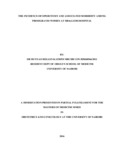| dc.contributor.author | Munyao, Hellen K | |
| dc.date.accessioned | 2016-12-22T09:32:15Z | |
| dc.date.available | 2016-12-22T09:32:15Z | |
| dc.date.issued | 2016 | |
| dc.identifier.uri | http://hdl.handle.net/11295/98277 | |
| dc.description.abstract | Background Episiotomy is the commonest obstetric surgical procedure after cord ligation that was introduced in practice in the 18th century without strong scientific evidence of its benefits, which included non reassuring fetal status, preterm delivery, assisted vaginal delivery and decreasing sexual, perineal and pelvic floor dysfunction. Episiotomy rates have been on decline in developed countries; however its rates remain higher than the recommended 10% (WHO) in developing countries despite the fact that few if any benefits to both the mother and the neonate exist.
Objective To determine the incidence of episiotomy, immediate and late outcomes and factors associated with morbidity at two weeks postpartum in primigravid women at Mbagathi Hospital.
Methodology The study was carried out at Mbagathi Hospital from May to July 2015 where 200 study participants who met the inclusion criteria were cumulatively recruited on first postnatal day and data on socio-demographic characteristics, obstetrics history, progress of labour, immediate neonatal and maternal outcomes recorded. One hundred and seventy four study participants turned up at two weeks postpartum for review and completion of data entry. Participants who did not turn up for review were dropped from the study. Data were analyzed via SPSS version 21 and presented as means medians and proportions in tables and figures together with discussion.
Results Episiotomy incidence rate in this study was 28.2% (49) and medio-lateral episiotomy was the only type practiced. Close to 48 % of study participants sustained posterior perineal tears. About 58% and 21% study participants sustained second and third degree perineal tears respectively. There was no association between immediate neonatal birth weight, babyُs sex, 5th minute apgar score and episiotomy. Women without episiotomy were more likely to sustain second and third degree posterior perineal tears. Episiotomy was significantly associated with delay in perineal wound healing, in that only 2% of participants with episiotomy had good wound apposition by two weeks postpartum compared to 53.6% of participants without episiotomy. The predictors of postpartum complications at two weeks were episiotomy and perineal tears OR 195.2; 95 % CI 40.8-933.2; P< 0.001.
Conclusion In this study episiotomy rate was found to be lower than rates of previous studies in K N H but higher than the 10% recommendation by WHO. Episiotomy was significantly associated with high maternal morbidity within two weeks postpartum; however women with episiotomy were less likely to sustain third degree perineal tears. The main predictors for postpartum maternal complications at two weeks in this study were presence of episiotomy and perineal tears
Recommendations There is need to emphasize on selective episiotomy practice in primigravid parturients. Hospitals need to invest more on continued medical education and training of birth attendants in basic surgical and delivery skills. Review of all postnatal mothers within two weeks will assist in timely diagnosis and management of complications. parturients with severe perineal trauma may benefit from prophylactic antibiotics.
1 | en_US |
| dc.language.iso | en | en_US |
| dc.publisher | University of Nairobi | en_US |
| dc.rights | Attribution-NonCommercial-NoDerivs 3.0 United States | * |
| dc.rights.uri | http://creativecommons.org/licenses/by-nc-nd/3.0/us/ | * |
| dc.title | The incidence of episiotomy and associated morbidity among primigravid women at Mbagathi hospital | en_US |
| dc.type | Thesis | en_US |
| dc.description.department | a
Department of Psychiatry, University of Nairobi, ; bDepartment of Mental Health, School of Medicine,
Moi University, Eldoret, Kenya | |



